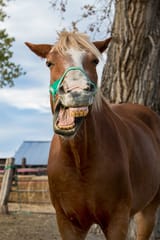>>509413322 (OP)
1. Horse legs are extremely fragile relative to their weight
Horses are large, heavy animals (1,000+ pounds) with very thin legs.
Their legs have very little muscle below the knee—just bone, tendon, and skin—so there's not much support for healing.
A broken leg often means a shattered bone, not a clean break. That’s very hard to fix.
2. Horses can’t rest or stay off a leg easily
Unlike dogs or humans, horses can’t use crutches or wheelchairs.
They need to bear weight on all four legs most of the time. If one leg is injured, the others have to compensate, which often causes laminitis (a painful, deadly condition in the other hooves).
If a horse can’t stand, it will often lie down too much, which can lead to colic, pressure sores, or organ failure.
3. Surgery and recovery are dangerous
Horse anesthesia is risky; many horses don’t survive being put to sleep and woken back up.
Post-surgical recovery often requires months of stall rest—which is unnatural and stressful for a horse.
Even with the best care, complications are extremely common: infections, re-injury, or chronic pain.
4. Quality of life
If the horse will suffer greatly and the chance of recovery is low, euthanasia is often considered more humane than forcing a long, painful recovery with little hope.
 7/3/2025, 7:40:10 PM
No.509413322
[Report]
>>509413477
>>509413511
>>509413595
>>509413789
>>509413884
>>509414199
>>509414212
>>509414878
>>509414972
>>509415092
>>509415614
>>509415689
>>509416555
>>509416744
>>509417046
>>509417287
>>509417357
>>509418012
>>509418403
>>509418981
7/3/2025, 7:40:10 PM
No.509413322
[Report]
>>509413477
>>509413511
>>509413595
>>509413789
>>509413884
>>509414199
>>509414212
>>509414878
>>509414972
>>509415092
>>509415614
>>509415689
>>509416555
>>509416744
>>509417046
>>509417287
>>509417357
>>509418012
>>509418403
>>509418981





















